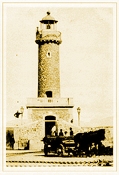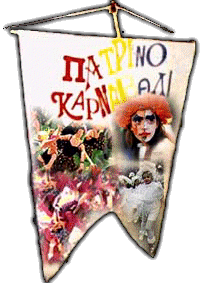


![]()
![]()
The formation of the city of Patras dates back to the period of Mycenaean years. It is the result of the conquest of the rural district of Aroi by the Achaians (around 1082 B.C.) and its subsequent merging with two other rural districts, Mesatida and Antheia. Patreas, head of the Achaians, that came in from Lakonia, gave his name to the new city.
In 280 B.C., Patras became one of the nine cities that established the Achaian Confederation and fighted with the Macedons initially and the Romans later. The city is finally subjugated to the Romans in 146 B.C.
During the hegemony of Neron Ceasar, Apostle Andreas prophesied Christianism at Patras. He was tortured, crucified and buried there, in 68 B.C.
Under the Roman occupation, Patras rendered in an important cultural centre and during the 2nd A.C. century the city was at its zenith.
The transfer of the capital of the Roman Empire to Konstantinople, marked the beginning of a decadance era for the city of Patras. During the Byzantine years it got marauded by the Goths (395 A.C.) and in 551 B.C. a strong earthquake was to completely destroy the city. Patras flourished again economically in the 9th A.C. century mainly due to silk commerce.
In 1460, it fell in Turkish hands. On March 21st, 1821, Palaion Patron Germanos declared at Patras' Saint George square the commencement of the Fight for Liberation. The revolution-pioneer city of Patras then wrote one of the most heroic chapters in Greek History. Patras is liberated in October 1828 and surrendered to French General Maizon that united the city with the rest of Greece.
Later, under Prime Minister Kapodistrias, the modern city of Patras was built on top of the ancient one.
![]()
Patras is the capital of the Achaia county, the third biggest city in Greece and the biggest in the Peloponnese region. Its population is approximately 250,000.
Geographically, it lies on the northwest part of the Peloponnese and is practically the gate of the country to the rest of Europe and the West. Patras' port welcomes hundreds -in summer even thousands- of tourists from Italy and Europe, daily.

The port
Almost 210 kilometers (130 miles) from the country's capital, Patras is a transportational hub that combines the conveniences of a megalopolis with the contact with nature. It offers an outlet to a great deal of outdoors activities to the nearby magical landscapes of the mountainous regions of Achaia and Nafpaktia as well as to the Ionian islands. It also offers a big variety of sports; from snow-skiing at the nearby Helmos mountain to open-sea sailing at the Patraikos Bay.
Surrounded by important sightseeing attractions as Olympia, Delphi, Kalavrita, the "Nymph of the Patraikos" is currently one of the nicest cities in Greece, offering high-quality living conditions. Characteristics of the city are the perfect street-plan and the magnificent public places (squares, the mole, the Castle etc). In the numerous cosmopolitan cafes, in the low-profile tavernas and ouzeries, Patras' inhabitans, peaceful and smily, steal the heart of every visitor. Adorers of intense work and even more intense fun, the people of Patras have cought the meaning of life.
![]()
The Castle, built on a hill on the position where the Ancient Acropolis once stood, overlooks the city. The areas around the Castle have recently been transformed in a park, known as "Dasyllio" (small forest).
To the rear of the Castle and around the Palaion Patron Germanou street, spreads the old city of Patras. Major attractions are the Ancient Odeum (the most important of its kind after the Herodeion Odeum of Athens), the 193 Steps of Agiou Nikolaou (Saint Nicholas) street that connect the old and new city and the Agiou Georgiou (Saint George) square where the Fight for Liberation was declared (see history, above).
The church of Saint Andreas, patron saint of Patras, is one of the biggest in the Balcans and lies on the city's south entrance. Beside it stands the restored byzantine church that was built in 1836-43 on the spot that Apostle Andreas has gotten crucified. The church had to be reconditioned due to its brutal destruction by the Turks.

Chruch of Saint Andreas, patron Saint of Patras
The turkish baths of Mboukaouri street are the only operating in Greece and the second in Europe, after those in Paris, France. The Municipal Theater, "Apollon" in George A' square is a copy of Milano's Scala and was constructed by architect Tsiler in 1827. Also in the centre of the city one can find the Archaelogical Museum, the Library and the City Hall. The numerous neoclassical buildings that are found in the centre of the city, attrack the visitor's attention. The squares like these of Psila Alonia, with the very tall phoenixes and the sundial, that of National Resistance (or Olgas square), and that of Trion Summaxon (Three Allies) near the port with the garden-clock are brilliant samples of the city's beauty.

The Trion Summaxon (Three Allies) square
The internationally renowned distillery of "аваза-CLAUSS" is located on a hill in the outskirts of Patras and operates since the previous century. Its facilities are built with such attention to detail that the establishment is often refered to as an industrial design exemplar. The facilities are frequently used for cultural events.
Patras' International Festival, that takes place annually during the months of July and August, is of high artistic interest and hosts artistic personages from all over the world.
Finally, the Carnival of Patras is an internationally famous event as well as a milestone in the city's life. It is carried out every year at the end of February or beginning of March (movable feast). Tenths of thousands of Patras' people -and not only- join each year the carnival groups (consisting of 150-300 persons) and with their own costumes participate in the various contests of the Treasure Hunt as well as in the parades. Groups and all kinds of Organizations and Associations organize their traditional "Costume Dances" in various night clubs and private halls. Highlights include the Night "On-Foot" Parade on the last Saturday and the Grand Parade on Carnival's last Sunday, when the whole city surrenders to a frantic continuous dance.

The Municipality of Patras, official sponsor of Patras' Carnival, keeps a discrete eye on the events and, along with the Carnival Committee, looks after the participants' safety at the same time it grades the quality of appearance of the groups. The Municipality as well takes part in the celebrations as it organizes the famous "Mbourmboulia", adult dances, at the Municipal Theater "Apollon".
![]()
Patras has a tradition in education. Every year, the fabulous "Guys from Patras", (not the greek music group but rather the candidates for entrance in the High Education Institutions of Greece) rank at the top of the Panhellenic score listing and occupy the most of the top-entrance positions, relatively to any Greek town.
Also, Patras is considered to be the homeland of traditional shadow play theater, the city where Karagkiozis became trully Greek. The indisputable shadow-puppet player of all times was Dimitrios Sardounis or "Mimaros", that was also a chanter at Saint Andreas church.

Karagkiozis of Patras
Patras has a glorious history in "rembetiko" songs, as well. Many consider Patras as the city that created and raised this kind of music.
Finally, the city of Patras has a long tradition in Scouting. As one of the first cities to embrace the Scouting ideals, it currently has some thousands of active members in the ten Scout Groups that operate in the center and the districts of the city. Among the tenths of thousands of Patras' people that have in the past been members of the Scout movement, is the present President of the Hellenic Republic, Mr. Konstandinos Stefanopoulos, an former Boy Scout in our Group (the Secong Scout Group of Patras) and, more particularly, in the Wildcats Patrol.

